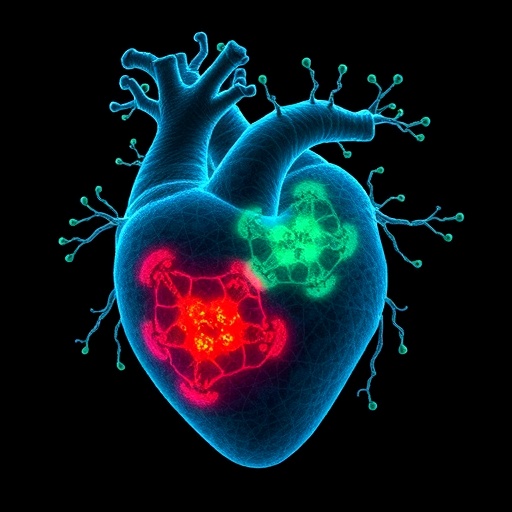Changes in the brain caused by Alzheimer’s disease are associated with shortening of the telomeres – the protective caps on the ends of chromosomes that shorten as cells age – according to a new study led by Anya Topiwala of Oxford Population Health, part of the University of Oxford, UK, published March 22 in the open-access journal PLOS ONE.

Credit: PublicDomainPictures, Pixabay, CC0 (https://creativecommons.org/publicdomain/zero/1.0/)
Changes in the brain caused by Alzheimer’s disease are associated with shortening of the telomeres – the protective caps on the ends of chromosomes that shorten as cells age – according to a new study led by Anya Topiwala of Oxford Population Health, part of the University of Oxford, UK, published March 22 in the open-access journal PLOS ONE.
Telomeres on chromosomes protect DNA from degrading, but every time a cell divides, the telomeres lose some of their length. Short telomeres are a sign of stress and cellular aging, and are also associated with a higher risk of neurological and psychiatric disorders. Currently, little is known about the links between telomere length and changes that occur in the brains of people with neurological conditions. Understanding those relationships could offer insights into the biological mechanisms that cause neurodegenerative disorders.
In the new study, researchers compared telomere length in white blood cells to results from brain MRIs and electronic health records from more than 31,000 participants in the UK Biobank, a large-scale biomedical database and research resource containing anonymized genetic, lifestyle and health information from half a million UK participants. The analysis revealed that patients with longer telomeres also tended to have better brain health. They had a larger volume of grey matter in their brains overall and a larger hippocampus, both of which shrink in patients with Alzheimer’s disease. Longer telomeres were also associated with a thicker cerebral cortex – the outer, folded layer of grey matter – which thins as Alzheimer’s disease progresses. The researchers speculate that longer telomeres might therefore help protect patients from developing dementia, though there was no association with stroke or Parkinson’s disease.
Overall, the findings show that shorter telomeres can be linked to multiple changes in the brain associated with dementia. To date, this is the largest and richest study of the relationships between telomere length and MRI markers in the brain. The associations suggest that accelerated aging in the brain, as indicated by telomere length, could represent a biological pathway that leads to neurodegenerative disease.
The authors add: “We found associations between telomere length, a marker of biological ageing, and multiple aspects of brain structure. This may explain why individuals with longer telomeres have a lower risk of dementia.”
#####
In your coverage please use this URL to provide access to the freely available article in PLOS ONE: https://journals.plos.org/plosone/article?id=10.1371/journal.pone.0282363
Citation: Topiwala A, Nichols TE, Williams LZJ, Robinson EC, Alfaro-Almagro F, Taschler B, et al. (2023) Telomere length and brain imaging phenotypes in UK Biobank. PLoS ONE 18(3): e0282363. https://doi.org/10.1371/journal.pone.0282363
Author Countries: UK
Funding: AT is supported by a Wellcome Trust (https://wellcome.org/) fellowship (216462/Z/19/Z). CW is funded, in part, by the China Scholarship Council (CSC, https://www.chinesescholarshipcouncil.com/). SMS is supported by a Wellcome Trust Collaborative Award 215573/Z/19/Z. KLM is supported by a Wellcome Trust Senior Research Fellowship (202788/Z/16/Z). TEN is supported by the Li Ka Shing Centre for Health Information and Discovery, an NIH grant (https://www.nih.gov/, TN: R01EB026859), the National Institute for Health Research Oxford Biomedical Research Centre (BRC-1215-20014), and a Wellcome Trust award (TEN: 100309/Z/12/Z). The telomere length measurements were funded by the UK Medical Research Council (MRC), Biotechnology and Biological Sciences Research Council and British Heart Foundation through MRC grant MR/M012816/1 to VC and NJS. VC and NJS are supported by the National Institute for Health Research (NIHR) Leicester Cardiovascular Biomedical Research Centre (BRC-1215-20010). FAA is funded by the UK Medical Research Council (MRC). LZJW is supported by the Commonwealth Scholarship Commission, United Kingdom. The funders had no role in study design, data collection and analysis, decision to publish, or preparation of the manuscript.
Journal
PLoS ONE
DOI
10.1371/journal.pone.0282363
Method of Research
Observational study
Subject of Research
People
Article Title
Telomere length and brain imaging phenotypes in UK Biobank
Article Publication Date
22-Mar-2023
COI Statement
TN “Paid statistical consultancy, Perspectum”. The other authors declare no competing financial interests. This does not alter the authors’ adherence to PLOS ONE policies on sharing data and materials.





